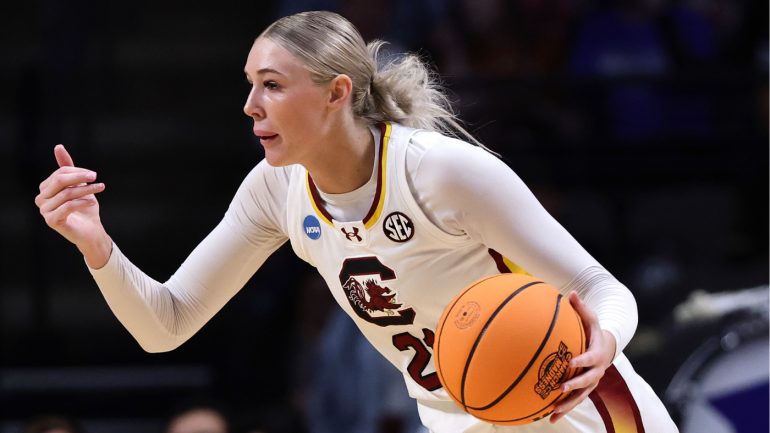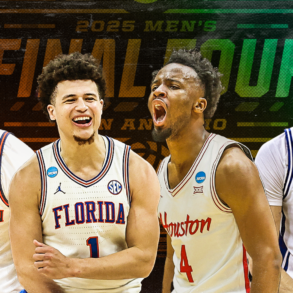
No. 1 seed South Carolina faced yet another scare in the 2025 Women’s NCAA Tournament, but held on for a 54-50 victory over No. 2 seed Duke in the Elite Eight. The Gamecocks are now on to the Final Four for the fifth consecutive season and their quest to become the first team to repeat as national champions since UConn won four in a row from 2013-16 remains alive.
They’ll face the winner of Monday night’s matchup between No. 1 seed Texas and No. 2 seed TCU.
As South Carolina prepares for a trip to Tampa, Florida, their ability to win it all is more in doubt than it has been at perhaps any other point in the season. The biggest concern for the Gamecocks is their offense, and in particular their lack of a go-to scorer.
The Gamecocks’ 54 points against Duke were a season low, and they turned it over 16 times, which was tied for their fourth-most in a game. They also shot 43.2% from the field, which was their ninth-worst effort. No one scored more than 14 points (Chloe Kitts), and Sania Feagin (12) was the only other player in double figures.
“I just hope that we can get our offense going a little bit,” South Carolina coach Dawn Staley said after escaping against Duke. “We can’t seem to just to play a little more fluidly.”
Raising questions about South Carolina’s offense is not an overreaction to one game against an elite Duke defense. The Gamecocks looked out of sorts at times against Maryland and Indiana in the last two rounds of the tournament as well, and had numerous rough outings against top competition throughout the season.
The overall numbers would tell you that South Carolina is one of the best offensive teams in the country, but there’s a significant difference between what they did in Quad 1 games compared to non-Quad 1 games.
| Full season | Non-Q1 games | Q1 games | |
|---|---|---|---|
|
Off. Rtg. |
114.1 |
125.8 |
107.5 |
|
eFG% |
51.2% |
54.9% |
49.1% |
|
oREB rate |
38.9 |
44.3 |
36.0 |
|
Turnover rate |
14.4 |
12.5 |
15.5 |
To be fair, other contenders see a similar drop-off against better teams. However, the Gamecocks have some unique issues that have plagued them come tourney time. Perhaps most notably, the difference in South Carolina’s efficiency in the halfcourt versus in transition is staggering.
In Quad 1 games, they’ve shot just 40.9% on halfcourt possessions, per CBB Analytics, which ranks 82nd in the country. That’s compared to 59.6% shooting on transition possessions. There are generally fewer fastbreak opportunities against better teams, and that’s even more true in the tournament when games slow to a crawl at times.
“Look, I mean, at this point it’s not going to look pretty. Okay? It’s not,” Staley said. “There are stretches in each game that is not going to look pretty … Some of it’s not going to look as smoothly as us coaches and players envision or how you practice, but you certainly have to get down and play the kind of game that’s presented in front of you, and we’ll do that.”
One of the main reasons the Gamecocks struggle to score in the halfcourt is their lack of a true No. 1 option. During past championship runs, the Gamecocks have always had someone to play through on the offensive end, whether it was A’ja Wilson, Aliyah Boston or Kamilla Cardoso.
This season, freshman forward Joyce Edwards, who comes off the bench, is their leading scorer with 12.7 points per game, and they have six different players averaging at least eight points. There are many benefits to the Gamecocks’ depth and by-committee approach, but sometimes you just need someone who can get you a bucket.
The Gamecocks have players who can do that. Just the other day, MiLaysia Fulwiley saved them in the Sweet 16 with 23 points and Chloe Kitts had a 25-point game in the SEC Tournament against Vanderbilt. But the who and when are always unclear, and as a result they can look lost at times on offense.
If the Gamecocks go on to win the title, Edwards’ 12.7 points per game would be the lowest average by a national champion’s leading scorer in the last 20 years. Only twice during that stretch has a team’s leading scorer been under 15 points per game. For the sake of space, here’s a comparison of the last 10 years of national champions.
| Season | Team | Leading scorer | PPG |
|---|---|---|---|
|
2024-25 |
South Carolina |
Joyce Edwards |
12.7 |
|
2023-24 |
South Carolina |
Kamilla Cardoso |
14.4 |
|
2022-23 |
LSU |
Angel Reese |
23.0 |
|
2021-22 |
South Carolina |
Aliyah Boston |
16.8 |
|
2020-21 |
Stanford |
Kiana Williams |
14.0 |
|
2018-19 |
Baylor |
Kalani Brown |
15.8 |
|
2017-18 |
Notre Dame |
Arike Ogunbowale |
20.8 |
|
2016-17 |
South Carolina |
A’ja Wilson |
17.9 |
|
2015-16 |
UConn |
Breanna Stewart |
19.4 |
|
2014-15 |
UConn |
Breanna Stewart |
17.6 |
| 2013-14 | UConn | Breanna Stewart | 19.4 |
It must be said that these issues are relative. The Gamecocks are in the Final Four and two wins away from another national championship. They have an elite defense, a unique level of depth and plenty of experience. It would not be a shock if they are lifting the trophy in Tampa next week.
To do so, though, they’ll need much better offensive performances than they’ve had so far in the tournament bar their first-round win over Tennessee Tech. Who will step up to lead the way?
This post was originally published on this site be sure to check out more of their content.




